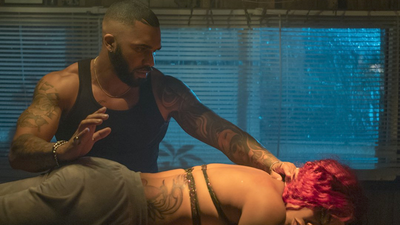The Significance of Hoodoo in P-Valley
P-Valley's Season 2 introduces Diamond, the Pynk's former bodyguard as a healing root worker. By doing so, the series exemplifies Black Southerners and their longstanding relationship with the slave folk magic.
In P-Valley’s fictional deep South City of Chucalissa, Black Southern culture is central. From the accents and music to strip club culture, the series has succeeded in providing an accurate portrayal of Southern living. And now, it’s highlighting another facet that is often not depicted in mainstream TV: Black people’s relationship with magic.
Diamond (Tyler Lepley) is a part of the chosen family that makes up the Pynk. Where the first season introduced him as a former military member turned strip club bodyguard (a role that he gave up after the fatal shooting that took place in Season 1), the second season properly introduces him as a root worker and Hoodoo practitioner. In the season’s second episode, “Seven Pounds of Pressure,” he proceeds to heal Mercedes’ shoulder that has given out, by magically removing seven pounds of pressure from the area. To add to the supernatural moment, he then weighs it on a set of scales, declaring that that same amount of pressure is needed to pull the trigger of a gun, leading to the reveal that it was Mercedes who fatally shot Montavius during the Season 1 finale.
Hoodoo, which is also known as root work or conjure, is an African-American tradition. In Hoodoo in America, Zora Neale Hurston — the famed author and anthropologist who studied the practice in the South in the ‘30s — wrote that it evolved from African spirituality and the Christian rituals slaves encountered in America. Though often confused with Voodoo, a West African religion, Hoodoo does not have specific gods or deities practitioners worship. Instead, there is a belief in spirits and life-giving energies.
"For its part, Conjure spoke directly to the slaves' perceptions of powerlessness and danger by providing alternative — but largely symbolic — means for addressing suffering,” Yvonne Chireau, a Professor of Religion at Swarthmore College, wrote in her book Conjure and Christianity in the Nineteenth Century: Religious Elements in African American Magic. “The Conjuring tradition allowed practitioners to defend themselves from harm, to cure their ailments, and to achieve some conceptual measure of control over personal adversity.”
Diamond’s root work has been happening since Season 1. Katori Hall, P-Valley executive producer, and showrunner recently explained in a Twitter thread that in the first episode of the series, his spiritual background was first presented when he gave Keyshawn (Shannon Thornton) a Carnelian necklace. When he shows her the necklace, he describes it as a “healin’ crystal” that was created from stone that belonged to a friend who died saving his life in Iraq. He also mentions that he’d like to give it to her for “courage and inner strength,” characteristics often associated with Carnelian crystals and stones.
Fast forward to episode three of Season 1, Diamond offers Keyshawn crushed pepper and alcohol poured on a rag as a remedy for muscle soreness. During this scene, Diamond says this is his grandfather’s remedy, signifying how Hoodoo is passed down lineages through family members. (Hall also mentioned on Twitter that this remedy was taken from lines of Zora Neale Hurston’s Mules and Men.)
With the most recent depiction of Hoodoo in Season 2, viewers are given a glimpse into the supernatural. The moment that occurs between Diamond and Mercedes in “Seven Pounds of Pressure” is somewhat akin to a section of Hurston’s Mules and Men, where she documented that spirits newly released from bodies are “likely to be destructive.” This essentially speaks to what happens in the scene; looking like an exorcism sequence out of a horror movie, Diamond attempts to vanquish Montavius’ spirit from Mercedes’ body, his spirit violently fighting back until Diamond succeeds.
With this latest episode, practicing root work has now become a major part of Diamond’s character, and has added an intriguing layer of complexity to him, too. While many may have felt Diamond was an angry hothead, Hoodoo allows him the space to present a softer and caring side that shows how far he’s willing to go to help those he really cares about.
For a mainstream show, P-Valley is succeeding so far in exploring this type of African spirituality. Historically, Hoodoo has been incorrectly equated to Voodoo, as well as wrongly appropriated. In terms of media representation, it’s often misrepresented, with stereotypical tropes like the “Magical Negro” or a character cursing someone they wish to harm, commonly used in a way that feels forced and inauthentic. All of these not only add to the negative connotation attached to Hoodoo but distort what it actually is, too. P-Valley’s exploration of this through Diamond is refreshing because it isn’t that, with the character’s relationship to the practice done in a way that doesn’t feel out of place.
By acknowledging a tradition that is still a part of Black people’s spiritual experience in the U.S., Hall and the rest of the P-Valley writer’s room are signaling how root work provides a direct link between us and our ancestors. Hopefully, the series will continue to explore these interesting ways through Diamond, and show how this practice is still something Black people rely on for their wellbeing.
